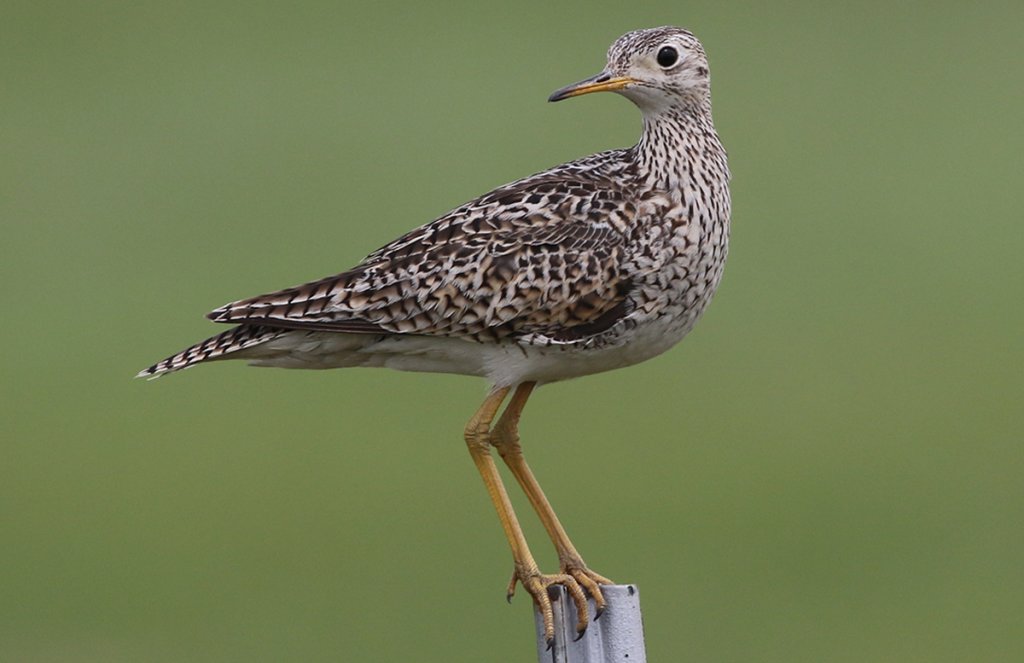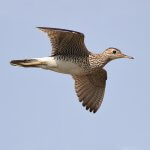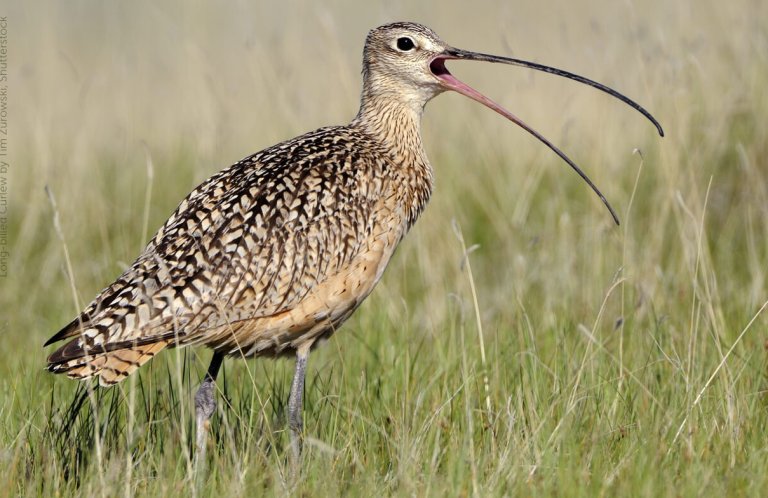About the Upland Sandpiper
The beautiful Upland Sandpiper, like the Mountain Plover, is technically a shorebird, but is almost always found far from any coast, a habitat preference reflected in folk names such as Grass Plover and Upland Plover. Its closest relative, the Long-billed Curlew, is another shorebird that breeds in open grasslands. Another of the Upland Sandpiper's former names, the Bartram's Sandpiper, is a nod to pioneering naturalist John Bartram, and remains this bird's genus name.
Notable field marks of the Upland Sandpiper are its big dark eyes, small, dove-like head, long yellow legs, shortish yellow bill, and long, wedge-shaped tail (the origin of its species name, longicauda). Its patterned brown, black, and gold plumage provides effective camouflage in its grassland habitats. On territory, the “Uppie” can often be sighted atop a conspicuous perch such as a fence post. When disturbed, it flies away with its wings held in a stiff downward curve; as it lands, it seems to pose, holding its wings up over its back for a few seconds before folding them.
The Upland Sandpiper is so closely tied to healthy shortgrass prairie that it's considered an “indicator species” for that habitat.
Prairie Proxy
In the same way that nesting Cerulean or Kentucky Warblers signify intact deciduous forest, so breeding Upland Sandpipers indicate healthy shortgrass prairies. The Upland Sandpiper is so closely associated with these native grasslands that biologists consider it to be an “indicator species,” for the quality of that habitat, along with other prairie birds such as the Sprague's Pipit and Baird's Sparrow. These indicator species are the first to show the effects of any change or degradation of their particular ecosystem.
Songs and Sounds
The unforgettable song of the Upland Sandpiper, given from the ground or in flight, is a series of bubbly notes and mellow, ascending whistles followed by a series of descending calls. Edward Forbush, in his Natural History of the Birds of Eastern and Central North America, described the Upland Sandpiper's song as “ethereal.”
This bird's alarm call is a chittering quip-ip-ip-ip.
Song:
Call:
Breeding and Feeding
During the breeding season, a male Upland Sandpiper hovers high over his territory while whistling and calling, and also displays to females on the ground. Once mated, a male and female often display together.
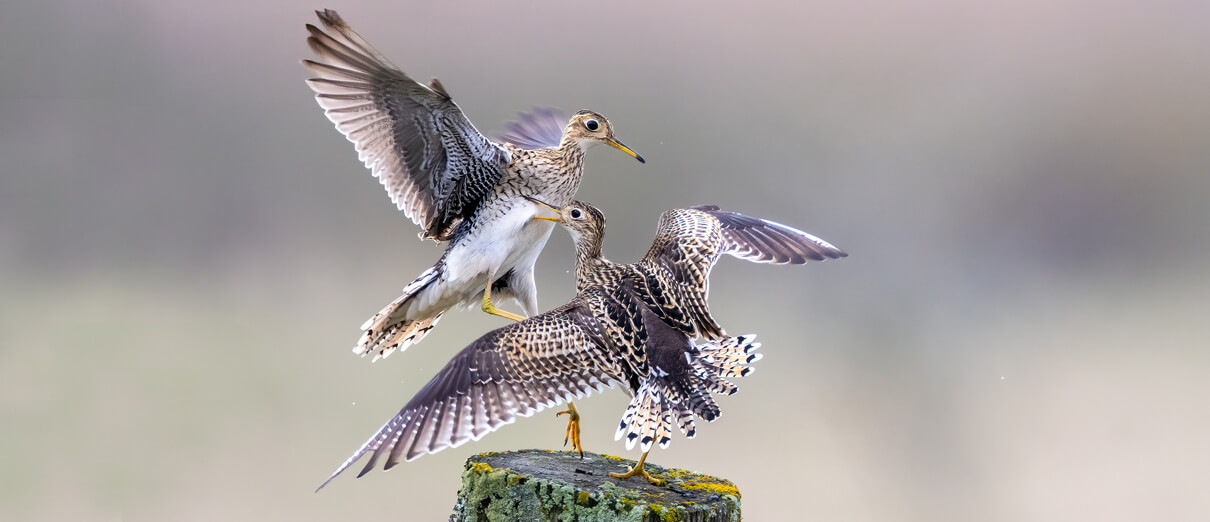
Like many grasslands birds ranging from the Western Meadowlark to the Thick-billed Longspur, the Upland Sandpiper nests on the ground, hidden among dense grasses. The male usually initiates nest-building by clearing a scrape, which the female completes before laying her clutch of four eggs. Both adults share incubation duties, which last about one month, and will perform distraction displays to lure predators away from the nest or young birds. The long-legged, downy chicks are able to leave the nest and feed themselves soon after hatching. They fledge in about another month and linger in the same area until migration begins.
The Upland Sandpiper forages as it walks along the ground, seeking prey by sight. It's mainly insectivorous, with a widely varied menu including grasshoppers, crickets, beetles, caterpillars, spiders, and other invertebrates. Its diet sometimes includes waste grains, grass seeds, and even small reptiles.
Region and Range
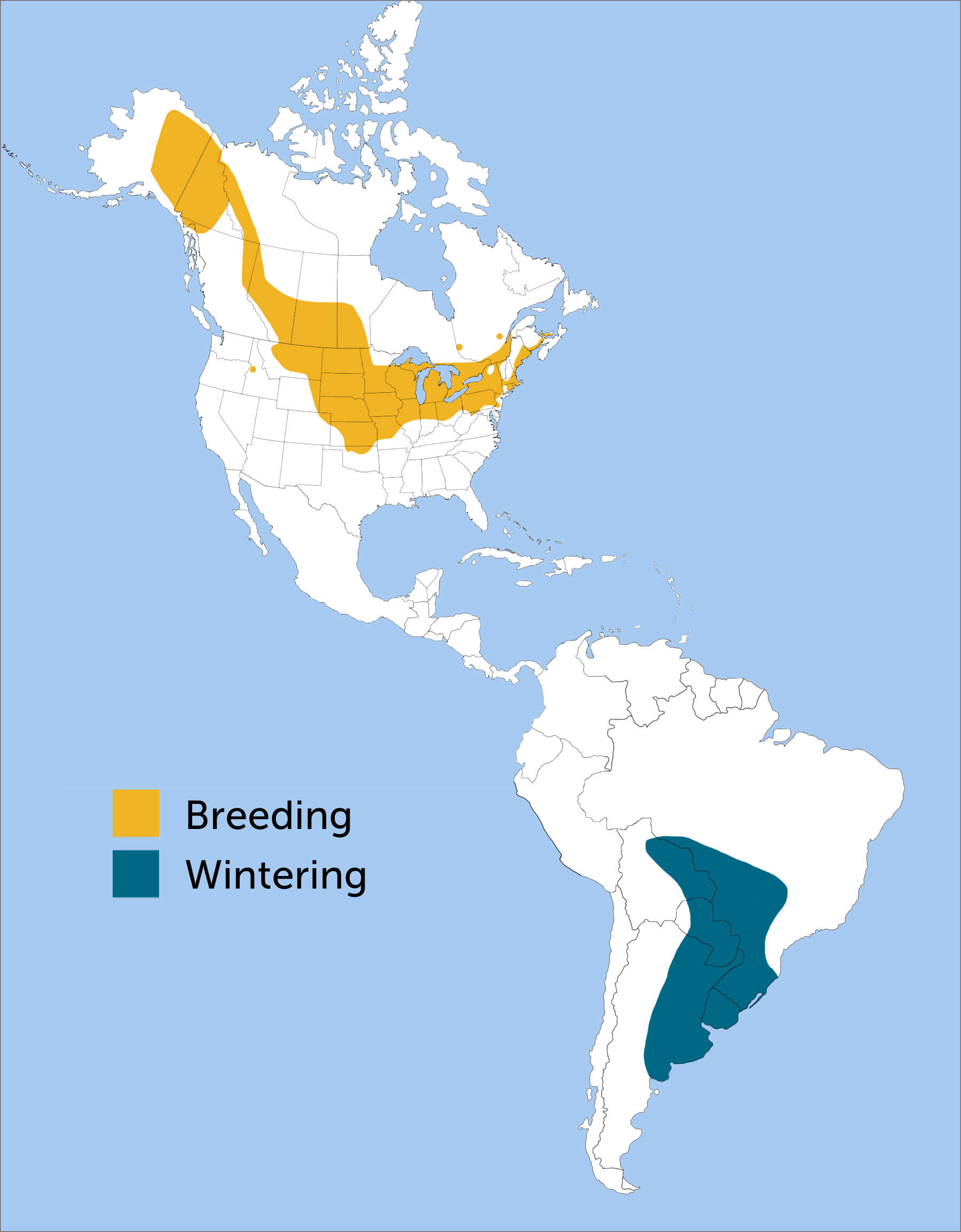
Although the Upland Sandpiper's main breeding range centers on native shortgrass prairies across the Great Plains of North America, scattered populations also nest at abandoned strip mines, blueberry barrens, and airports in the east. Some also nest in pasture, fallow fields, upland tundra, and mountain meadows. It can be found in similar open habitats on its wintering grounds in northeastern Argentina, Uruguay and southern Brazil.
Like many members of the shorebird family such as the Buff-breasted Sandpiper and Red Knot, the Upland Sandpiper is a champion long-distance migrant, crossing continents twice-yearly during flights of over 3,000 miles each way, with populations that winter in Argentina and Uruguay flying as much as 6,000 miles. It's an early migrant, with most birds beginning their journey south soon after breeding concludes; most are on their way south by the end of August.
Conservation
While Upland Sandpiper numbers increased as forests were cleared in the early 19th century, they declined sharply later in that century due to market hunting, which caused the outright extinction of other species such as the Passenger Pigeon. Currently, the Upland Sandpiper's overall population is gradually increasing, with numbers in the Great Plains on the rise while eastern populations have dropped significantly.

Help support ABC's conservation mission!
Like so many migratory birds, the Upland Sandpiper depends upon habits across the Americas; the loss of grasslands in South America is equally catastrophic as the disappearance of native prairie in the U.S. and Canada. Ongoing habitat loss has led the disappearance of Upland Sandpiper populations in eastern and western North America, and this bird is listed as Endangered in many U.S. states. Upland Sandpipers also suffer from the increase in early and multiple hay harvests, which mow over nests and young birds.
ABC supports habitat improvement measures such as controlled, periodic burns and rotational grazing which benefit the Upland Sandpiper and many other birds. We consistently advocate for the Farm Bill, which can boost funding for bird habitat conservation. Our BirdScapes program recognizes the need for habitat conservation throughout migratory birds' life cycles and continues work to conserve and restore critical grassland habitats that the Upland Sandpiper needs to thrive.
ABC and partner Asociación Armonía have protected an important stopover site for Upland Sandpipers at Bolivia's Barba Azul Reserve, where these birds pause during fall migration to feed and rest before continuing their long journey to more southerly grasslands.
Get Involved
Policies enacted by the U.S. Congress and federal agencies, such as the U.S. Fish and Wildlife Service, have a huge impact on U.S. birds. You can help shape these rules for the better by telling lawmakers to prioritize birds, bird habitat, and bird-friendly measures. To get started, visit ABC's Action Center.
Living a bird-friendly life can have an immediate impact on the birds around you. Doing so can be as easy as adding native plants to your garden, avoiding pesticides, and keeping cats indoors. To learn more, visit our Bird-Friendly Life page.
American Bird Conservancy and our Migratory Bird Joint Venture partners have improved conservation management on more than 8.5 million acres of U.S. bird habitat — an area larger than the state of Maryland — over the last ten years. This is a monumental undertaking, requiring the support of many, and you can help by making a gift today.





































